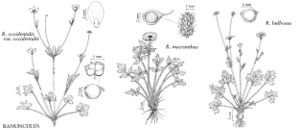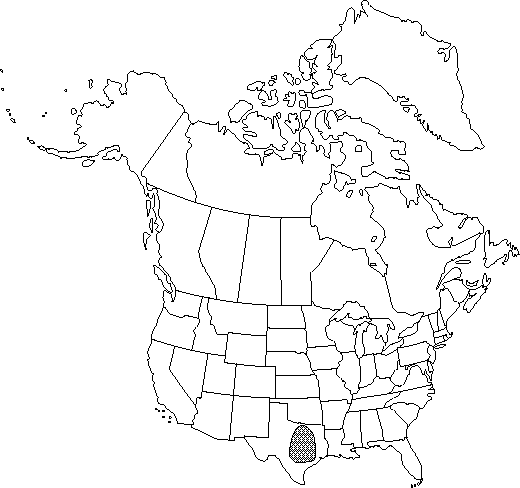familyRanunculaceae
genusRanunculus
subgenusRanunculus subg. Ranunculus
sectionRanunculus sect. Ranunculus
speciesRanunculus macranthus
Difference between revisions of "Ranunculus macranthus"
Linnaea 21: 585. 1848.
EndemicSelected by author to be illustrated
Synonyms: Variety (Small) L. D. Benson
Treatment appears in FNA Volume 3.
FNA>Volume Importer |
FNA>Volume Importer |
||
| Line 26: | Line 26: | ||
}}<!-- | }}<!-- | ||
| − | --><span class="statement" id="st- | + | --><span class="statement" id="st-undefined" data-properties=""><b>Stems </b>erect or decumbent, never rooting nodally, hispid, base not bulbous. <b>Roots</b> tuberous. <b>Basal</b> leaf blades ovate in outline, 3-5-foliolate, 3.8-10 × 2.7-9 cm, leaflets 1×-lobed, ultimate segments narrowly elliptic to oblanceolate, margins entire or with few teeth, apex broadly acute to rounded-obtuse. <b>Flowers</b>: receptacle hispid; sepals spreading or weakly reflexed ca. 1 mm above base, 7-10 × 3-5 mm, hispid; petals 10-22, yellow, 12-22 × 4-9 mm. <b>Heads</b> of achenes globose to cylindric, 8-14 × 8-10 mm; achenes 2.2-4.2 × 2.8-3.4 mm, glabrous, margin forming narrow rib 0.4-0.6 mm wide; beak usually persistent, filiform from deltate base, straight, 2-4 mm. <b>2n</b> = 32.</span><!-- |
-->{{Treatment/Body | -->{{Treatment/Body | ||
| Line 56: | Line 56: | ||
|publication year=1848 | |publication year=1848 | ||
|special status=Endemic;Selected by author to be illustrated | |special status=Endemic;Selected by author to be illustrated | ||
| − | |source xml=https://jpend@bitbucket.org/aafc-mbb/fna- | + | |source xml=https://jpend@bitbucket.org/aafc-mbb/fna-data-curation.git/src/9216fc802291cd3df363fd52122300479582ede7/coarse_grained_fna_xml/V3/V3_233.xml |
|genus=Ranunculus | |genus=Ranunculus | ||
|subgenus=Ranunculus subg. Ranunculus | |subgenus=Ranunculus subg. Ranunculus | ||
|section=Ranunculus sect. Ranunculus | |section=Ranunculus sect. Ranunculus | ||
|species=Ranunculus macranthus | |species=Ranunculus macranthus | ||
| − | |||
| − | |||
| − | |||
| − | |||
| − | |||
| − | |||
| − | |||
| − | |||
| − | |||
| − | |||
| − | |||
| − | |||
| − | |||
| − | |||
| − | |||
| − | |||
| − | |||
| − | |||
| − | |||
| − | |||
| − | |||
| − | |||
| − | |||
| − | |||
| − | |||
| − | |||
| − | |||
| − | |||
| − | |||
| − | |||
| − | |||
| − | |||
| − | |||
| − | |||
| − | |||
| − | |||
| − | |||
| − | |||
}}<!-- | }}<!-- | ||
-->[[Category:Treatment]][[Category:Ranunculus sect. Ranunculus]] | -->[[Category:Treatment]][[Category:Ranunculus sect. Ranunculus]] | ||
Revision as of 14:36, 27 July 2019
Stems erect or decumbent, never rooting nodally, hispid, base not bulbous. Roots tuberous. Basal leaf blades ovate in outline, 3-5-foliolate, 3.8-10 × 2.7-9 cm, leaflets 1×-lobed, ultimate segments narrowly elliptic to oblanceolate, margins entire or with few teeth, apex broadly acute to rounded-obtuse. Flowers: receptacle hispid; sepals spreading or weakly reflexed ca. 1 mm above base, 7-10 × 3-5 mm, hispid; petals 10-22, yellow, 12-22 × 4-9 mm. Heads of achenes globose to cylindric, 8-14 × 8-10 mm; achenes 2.2-4.2 × 2.8-3.4 mm, glabrous, margin forming narrow rib 0.4-0.6 mm wide; beak usually persistent, filiform from deltate base, straight, 2-4 mm. 2n = 32.
Phenology: Flowering late winter–spring (Mar–May).
Habitat: Riverbanks and wet meadows
Elevation: 0-400 m
Discussion
Selected References
None.
Lower Taxa
None.

